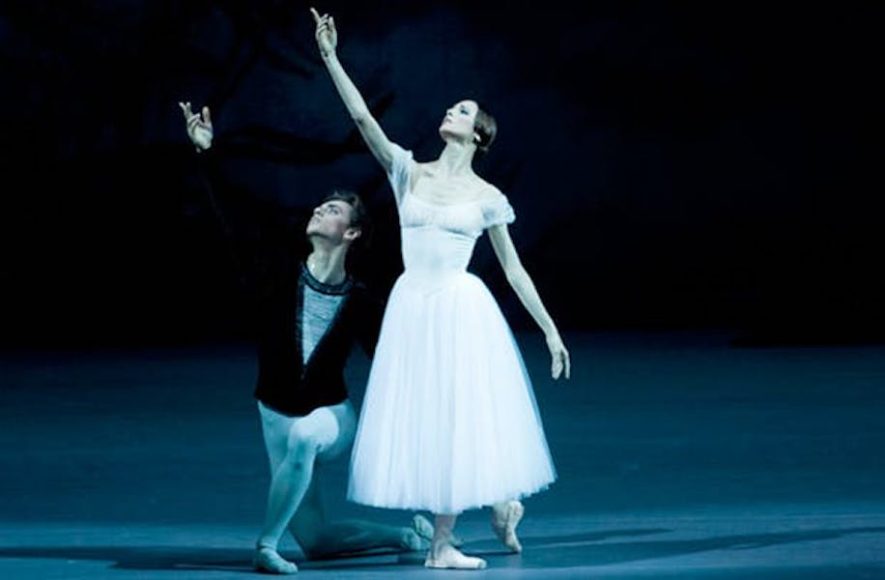The ballet “Giselle” – the quintessence of 19th-century Romanticism – tells the story of a simple, open-hearted peasant girl driven mad for love of Albrecht, a man who’s hidden his aristocratic identity and engagement to another. Dying, Giselle becomes a Wili, one of the female spirits compelled to avenge themselves on the men who wronged them in life by dancing them to death.
In the excellent, though far from perfect, Bolshoi Ballet production given an encore simulcast last Sunday in theaters around the world, there was a great moment in Act 2 when the Wilis dispensed with Hans, Giselle’s unrequited suitor, whose jealousy of the beloved Albrecht sets the tragedy in motion. Under Yuri Grigorovich’s choreography, two of the lead Wilis basically tossed Hans away. They were like elegant bouncers. The ladies sitting behind us at City Center 15: Cinema de Lux in White Plains really enjoyed that. Laughing, one whispered to another, “That takes care of him.”
Welcome to “Giselle” in the age of #MeToo and the Time’s Up movements. Last week’s South African reimagining of the work at the Joyce Theater in Manhattan offered a contemporary feminist interpretation. But even in traditional productions like the Bolshoi’s, it’s hard not to see this 1841 work in the context of our own time, in which women are simply no longer willing to put up with any more abuse
Of course, much of that depends on the characterization of Albrecht. For years, up to the time of Erik Bruhn and even Rudolf Nureyve in the 1950s and ’60s, Albrecht was portrayed as a man who slummed it with Giselle before getting it on with Bathilde, his betrothed. But in the 1970s, Anthony Dowell and Mikhail Baryshnikov did much to foster the idea of the antihero Albrecht: He loves Giselle but he’s trapped in a situation not of his making that will ultimately doom her. On Sunday, Sergei Polunin – the reigning Brando of ballet – made it clear from the start that this was an Albrecht who, though engaged, had given his heart to Giselle. The moment in Act 2 when he touched the name on her gravestone was a tender gesture from a man who has already made the Baryshnikovian leap to screen (“Red Sparrow,” “Murder on the Orient Express” and Ralph Fiennes’ upcoming Nureyev defection drama “The White Crow”).
Such an Albrecht goes a long way to explaining a Giselle lost to love and yet able to conjure enough of that love ultimately to save him. In Sunday’s simulcast, however, Svetlana Zakharova’s Giselle needed no such encouragement. The role is to prima ballerinas what Hamlet is to actors, as Dowell’s and Baryshnikov’s frequent partners – Natalia Makarova and Gelsey Kirland respectively — demonstrated. You have to be a great actress in the earthy Act 1 and a great dancer/technician in the spectral Act. 2. From her entrance, Zakharova was Giselle – innocent, open-hearted and yet willing to stake a claim to her man and her own happiness. The compassion that infused her ghostly presence in Act 2 as she protectively embraced Polunin’s devastated Albrecht was at the heart of this production.
The rest of the cast and presentation were their equals. Ekaterina Shipulina was superbly steely as Myrtha, the implacable Queen of the Wilis (and, in contrast, charming in a behind-the-scenes interview with the multilingual host Katya Novikova). Pavel Klinichev’s crisp musical direction and Vincent Bataillon’s equally lucent TV direction enhanced the encore presentation.
Only the lackluster Act 1 pas de deux by Daria Khokhlova and a technically wobbly Igor Tsvirko prevented a marvelous entertainment from being a truly great one.
You were left nonetheless with the memory of Zakharova and the realization that regardless of gender, compassion, not vengeance, is the greatest strength.
One final thought: “Giselle” is a work of the male imagination (librettists Théophile Gautier and Jules-Henri Vernoy de Saint-Georges, working from a story by Heinrich Heine; composer Adolphe Adam; choreographers Jules Perrot and Jean Coralli). So perhaps whatever female strength, compassion and vengeance audiences find in the ballet is nothing more than a projection of male guilt at the shabby way in which they have often treated women.)
For more about ballet on screen, visit BolshoiBalletInCinema.com and fathomevents.com. And for more on Sergei Polunin, look for WAG’s profile in our June “Inspired Journeys” issue.

